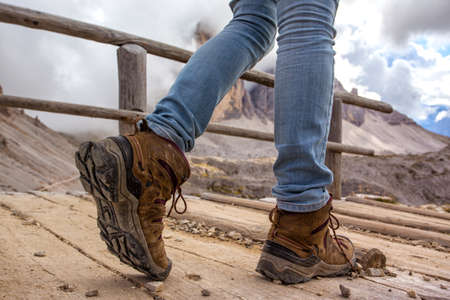1. Introduction
When it comes to hiking in the UK, where the terrain ranges from rugged fells and boggy moorlands to windswept coastal paths, selecting the right walking boots is crucial for both comfort and safety. The choice between leather and synthetic walking boots remains a perennial debate among British hikers, each material offering distinct advantages and drawbacks suited to varying conditions. Understanding the key differences in materials and construction is essential for making an informed decision tailored to UK landscapes, notorious for their unpredictable weather and challenging underfoot conditions. This comprehensive comparison aims to guide hikers through the nuances of leather versus synthetic walking boots, helping you invest in footwear that will support your adventures across Britain’s diverse trails.
2. Material Construction: Leather vs Synthetic
When selecting walking boots for British hiking conditions, the choice between leather and synthetic materials is pivotal. Both options come with distinct advantages and potential drawbacks, particularly when considering the UK’s notoriously unpredictable weather, varied terrains, and tradition of long-distance footpaths. Below is a detailed comparison of key material properties:
| Property | Leather Boots | Synthetic Boots |
|---|---|---|
| Durability | Full-grain leather is renowned for its longevity, often outlasting synthetic alternatives when properly maintained. It withstands abrasion from rocky fells and dense undergrowth typical of routes like the Lake District or Scottish Highlands. | Modern synthetics (nylon, polyester, and engineered mesh) are lighter but may be more prone to wear over time, especially on rugged terrain. However, technological advancements have significantly improved their lifespan in recent years. |
| Waterproofing | Leather naturally repels water and can be treated with waxes or creams to enhance waterproofing—essential for wet British weather. However, once saturated, drying times are lengthy. | Synthetics often incorporate waterproof membranes (e.g., Gore-Tex), providing effective initial resistance to rain and puddles. They dry faster than leather but may lose waterproofing over time as seams and membranes degrade. |
| Breathability | Leather offers moderate breathability; it excels at maintaining warmth in cold, damp climates but can feel stifling on warmer days or during strenuous ascents. | Synthetic materials generally provide superior ventilation, keeping feet cooler and reducing sweat build-up—an advantage for summer hikes or multi-day treks along the South West Coast Path. |
UK-Specific Considerations
The UK’s climate demands footwear that copes with frequent rain, muddy paths, and rapid temperature shifts. Leather boots are favoured by many experienced British walkers for winter hillwalking and extended expeditions due to their robustness and ability to mould to the foot over time. Conversely, synthetic boots are increasingly popular among casual hikers and those prioritising lightweight gear for shorter or summer outings.
Summary Table: Suitability by Condition
| Condition | Recommended Material | Reasoning |
|---|---|---|
| Wet & Muddy Terrain (e.g., Peak District) | Leather | Superior water resistance; durability against abrasive mud and grit. |
| Warm Weather/Long Distances (e.g., South Downs Way) | Synthetic | Lighter weight; better breathability reduces fatigue and blisters. |
| Cold & Windy Conditions (e.g., Scottish Munros) | Leather | Better insulation and protection from wind chill. |
| Frequent Drying Needed (multi-day camping) | Synthetic | Faster drying if soaked; less maintenance required overnight. |
Final Thoughts on Materials for UK Hikers
Your choice should reflect not only your typical walking environment but also your willingness to maintain your boots. Leather excels in traditional British hillwalking scenarios but requires regular care. Synthetics offer convenience and comfort for modern hikers who value speed and minimal fuss. Ultimately, understanding these material differences ensures you select the best boot for your adventures across the diverse landscapes of the UK.

3. Comfort and Fit
When it comes to choosing between leather and synthetic walking boots, comfort and fit are paramount—especially for UK hikers who often face unpredictable weather and a variety of terrains, from the rugged Lake District to the boggy trails of the Scottish Highlands.
Leather Walking Boots: Breaking In and Long-Term Comfort
Leather boots are renowned for their superior support and durability, but they do require a substantial break-in period. Initially, hikers may experience some stiffness, but over time, quality leather moulds to the unique shape of your foot, offering a bespoke fit that excels during long-distance treks. This is especially advantageous for those who regularly tackle challenging UK trails, where stability and foot protection are critical. However, it’s important to note that in wet British conditions, leather can feel heavier when saturated and may take longer to dry.
Synthetic Walking Boots: Instant Comfort and Flexibility
Synthetic boots typically provide greater out-of-the-box comfort due to lighter materials and increased flexibility. For walkers who prioritise immediate wearability or those planning shorter day hikes across variable UK landscapes, synthetics are often favoured. The breathability of modern synthetic fabrics helps reduce overheating on milder days—a frequent concern during spring and autumn rambles—but this can come at the expense of long-term support.
Climate Considerations: Adapting to UK Weather
The UK’s famously changeable climate means that hikers must consider both insulation and ventilation. Leather offers natural insulation for colder months, while synthetic options tend to excel in warmer or damp conditions by drying quickly and allowing better airflow. Selecting the right boot also involves considering sock thickness—a common practice among British hikers—to further fine-tune fit and comfort according to seasonal needs.
Fit Tips for UK Hikers
No matter the material, achieving the right fit is essential. Always try boots on with your preferred hiking socks and consider any orthotic inserts if you use them. Remember that feet can swell after hours on the trail, so a little extra room in the toe box is advisable. Ultimately, whether you opt for leather’s tailored feel or synthetic’s instant comfort, ensuring a proper fit will help you avoid blisters and discomfort—making every walk across Britain’s diverse countryside more enjoyable.
4. Performance in British Weather
One of the most critical considerations for UK hikers when choosing between leather and synthetic walking boots is their performance across the notoriously unpredictable British weather. The UK’s hiking environment is defined by frequent rain, persistent mud, and damp conditions, which demand footwear that can withstand moisture while maintaining comfort and functionality.
Water Resistance
Leather boots, especially those made from full-grain leather, are renowned for their natural water resistance. When properly treated with waxes or waterproofing agents, they can repel water effectively, keeping feet dry during extended wet spells. However, untreated leather can absorb water over time, leading to heavier boots and potential discomfort.
Synthetic boots typically come with integrated waterproof membranes such as Gore-Tex or eVent, offering immediate protection against rain and puddles. While these membranes perform well initially, prolonged exposure to wet conditions can sometimes cause the lining to fail or allow seepage at the seams.
Mud Management
The thick, sticky mud found on many UK trails poses a challenge for both types of boots. Leather’s smooth surface makes it easier to clean after a muddy trek, but heavy mud can stick and add weight. Synthetic boots often feature more textured or layered uppers, which may trap mud but are generally lighter and quicker to dry if they become saturated.
Breathability in Damp Climates
Maintaining breathability is crucial in the UK’s humid climate. Leather boots tend to offer less breathability compared to synthetics, especially once wet. This can lead to sweat build-up inside the boot during long hikes. In contrast, synthetic materials are designed for enhanced airflow and quick drying, reducing the risk of blisters caused by excess moisture.
Comparative Table: Leather vs Synthetic Boots in UK Weather Conditions
| Condition | Leather Boots | Synthetic Boots |
|---|---|---|
| Heavy Rain | Highly water-resistant with proper treatment; can become heavy if soaked | Excellent initial water resistance; may leak after prolonged exposure |
| Mud | Easy to clean but retains weight when muddy | Lighter; dries quickly but mud may cling to textured surfaces |
| Breathability | Limited; can feel clammy during damp hikes | Superior airflow; faster drying reduces blister risk |
| Cold & Damp | Keeps feet warmer due to thicker material | Can feel colder; insulation varies by model |
Summary Assessment
In summary, both leather and synthetic walking boots have distinct advantages and drawbacks when confronted with British weather. Leather excels in durability and warmth but requires regular maintenance to maintain its waterproof qualities. Synthetic boots offer superior breathability and quick-drying capabilities, making them particularly suited for hikers who prioritise comfort in wet conditions. Ultimately, your choice should reflect your typical hiking environments and personal preference for maintenance versus convenience.
5. Maintenance and Longevity
When investing in walking boots, UK hikers should give due consideration to the maintenance requirements and expected longevity of both leather and synthetic options. The variable British climate—with frequent rain, mud, and temperature fluctuations—means that proper care is crucial for performance and durability. Below, we offer practical advice tailored to local conditions and typical outdoor practices.
Leather Walking Boots: Care and Repair
Leather boots are well-known for their durability and ability to mould to the shape of your feet over time. However, this longevity is highly dependent on regular maintenance. In the UK, where wet and muddy trails are common, it’s essential to clean off mud with lukewarm water after each walk and allow the boots to dry naturally—never on a radiator or in direct sunlight, as this can cause the leather to crack. Applying a suitable wax or conditioning cream helps maintain water resistance and suppleness. Scuffs and minor damage can often be repaired with specialist products or by a reputable cobbler, making them a long-term investment if properly cared for.
Synthetic Walking Boots: Ease of Upkeep
Synthetic boots require less intensive maintenance, which appeals to many hikers who prioritise convenience. After use, simply brush off dirt and wipe down with a damp cloth; most synthetics dry quickly, an advantage during consecutive days on the trail. While waterproof membranes can degrade over time—especially after exposure to grit or salt—it’s possible to refresh water repellency with spray-on treatments readily available from outdoor shops across the UK. However, synthetic materials are generally less receptive to repair; once seams split or fabric wears through, replacement is usually necessary rather than refurbishment.
Lifespan Comparison
Under typical British hillwalking conditions, quality leather boots—if meticulously maintained—can last upwards of five years or more. They’re especially valued by seasoned leaders for multi-day expeditions where reliability is paramount. Synthetic boots may have a shorter lifespan (often two to four years), but their lighter weight and quick-drying properties make them popular for casual walkers or those who cover shorter distances in less demanding environments.
Practical Advice for UK Hikers
Ultimately, choosing between leather and synthetic walking boots involves balancing upkeep commitment against intended use. If you’re prepared to invest time in care routines—and perhaps appreciate traditional craftsmanship—leather is a sound choice for enduring reliability. For those seeking minimal fuss or who favour lightweight kit on mixed terrain, synthetics offer a pragmatic alternative despite their relative disposability. Whichever you choose, regular checks for wear and timely cleaning will extend the life of your footwear—a worthwhile habit for every UK hiker.
6. Environmental Impact and Sustainability
When selecting walking boots, UK hikers are increasingly aware of the environmental consequences associated with their choices. The eco-friendliness of leather and synthetic materials is a significant factor, reflecting broader consumer values around sustainability and responsible consumption.
Leather Walking Boots: Natural Origins but Complex Footprint
Leather, a natural material, is often perceived as a more sustainable choice due to its durability and biodegradability. However, its environmental impact is nuanced. The leather industry is resource-intensive, involving substantial water usage and chemical treatments during tanning processes. In the UK, some manufacturers have made strides in adopting vegetable tanning methods and sourcing hides as by-products of the food industry, reducing waste. Nonetheless, concerns remain regarding animal welfare, deforestation linked to cattle farming, and carbon emissions throughout the supply chain.
Synthetic Walking Boots: Innovation Meets Responsibility
Synthetic boots are typically produced from petroleum-based materials such as nylon or polyester. These materials require less water in manufacturing but are derived from non-renewable resources and can be energy-intensive to produce. While synthetic boots often feature recycled content and vegan credentials—which resonate with many environmentally conscious British consumers—they are not biodegradable and contribute to microplastic pollution if not properly disposed of at end-of-life.
UK Consumer Awareness and Values
British hikers increasingly prioritise sustainability, influenced by national campaigns on climate change and responsible outdoor practices. Many brands now offer transparency about their production methods, carbon footprint, and supply chains to appeal to the UK’s eco-savvy market. Labelling such as ‘recycled materials’, ‘locally sourced’, or ‘low-impact tanning’ helps hikers make informed decisions aligned with their values.
Making an Informed Choice for the Countryside
Ultimately, both leather and synthetic walking boots present environmental trade-offs. Leather offers longevity but raises ethical questions; synthetics provide innovation but raise concerns over plastic waste. For UK hikers who value sustainability, considering repairability, product lifespan, and end-of-life recycling options is essential. Opting for brands committed to environmental stewardship ensures that enjoying Britain’s countryside does not come at the planet’s expense.
7. Cost and Value for UK Buyers
When selecting between leather and synthetic walking boots, UK hikers will inevitably weigh up cost as a key factor. Leather boots generally command a higher upfront price, reflecting their robust construction, premium materials, and longer lifespan. Well-made leather models from respected brands can range from £120 to over £250, especially when crafted in the UK or Europe. However, this initial investment often pays off over time, as leather boots—when properly cared for—can last many years and even be resoled, offering excellent long-term value.
Synthetic boots, on the other hand, are typically more affordable, with reputable options available from around £60 to £150. They appeal to budget-conscious walkers or those seeking a lightweight boot for occasional use. Advances in technology have closed much of the durability gap, but synthetics may still wear out faster than quality leather—particularly with heavy use on rugged British terrain.
For best value, consider your frequency of walking, typical routes (from Lake District fells to South Downs paths), and personal priorities. A seasoned hillwalker tackling year-round conditions may find greater long-term savings in durable leather boots. Casual ramblers or those venturing out mainly in milder weather might prefer synthetics for their lower cost and lighter feel.
Advice for UK Walkers
- Shop during end-of-season sales: Many outdoor retailers offer significant discounts on both leather and synthetic models outside peak hiking seasons.
- Try before you buy: Fit is crucial; visit local shops to ensure comfort and sizing are spot-on for British foot shapes and walking styles.
- Invest according to needs: Don’t overspend on features you won’t use; focus on durability and support relative to your hiking ambitions.
Ultimately, the best value walking boot is the one that fits your feet, suits your adventures across the diverse UK landscape, and aligns with your budget—whether it’s a classic leather pair built for the long haul or a modern synthetic model offering affordability and agility.


